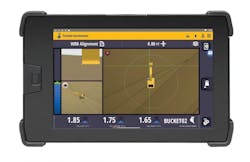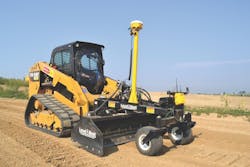Grade-Control Gains Ground
Take a few minutes to click through the websites of major suppliers of positioning and machine-control systems, and you’ll likely agree with Topcon Positioning System’s Murray Lodge, senior vice president and general manager of the company’s Construction Business Unit, that the technical advancement in this area during the past five years or so has probably eclipsed that of the preceding 25 years. This isn’t to say, though, that the technical challenges of the past weren’t difficult—extremely difficult.
Above: The use of IMU technology has allowed the development of mast-less GNSS grade control.
Seems not all that long ago that the very smart people who work for these companies were working diligently to crack some tough technical nuts, such as how to “rugged-ize” GPS hardware to make it last in harsh environments—and how to attain horizontal and vertical accuracies from satellite-based systems sufficient to make positioning technology viable for mining and earthmoving applications.
Today, no one gives much thought to GNSS (Global Navigation Satellite System) antennas, receivers, or base stations malfunctioning in even the harshest environments, and the enhanced accuracy of various positioning systems allows precise control of grades and contours in mining, earthmoving, and paving applications—in some instances attaining vertical accuracies of a few millimeters when GNSS and laser systems work in combination, or when universal total stations are used.
Surveying and machine control—the latter involving either automatically positioning the machine’s work tool, or, providing real-time guidance that allows the operator to precisely position the work tool—remain at the heart of what most positioning-technology companies are about. Advances in related areas, however, have allowed these companies to develop what typically are called digital site-management systems.
“We have customers today who are looking for ways to tie projects together from beginning to end,” says Topcon’s Lodge. “They’re asking for tools that will help them bid the job, plan the job for the greatest efficiency—for instance, setting up the best mass-haul routes or positioning the crusher to minimize haul distances—and tools that help them track and evaluate progress, perhaps using UAS [unmanned aerial systems]. Basically, they’re asking, ‘how do I get pertinent information in real time in order to make competent decisions throughout the construction process.’”
For example, Topcon’s Enterprise Solutions, says Lodge, is a work-flow management system that enables this kind of control—connecting sites, data, crews, and equipment. The system, he says, provides constant communication, data sharing, scheduling, and accurate productivity information in real time, no matter where the work site or office might be located.
Trimble Navigation’s Scott Crozier, director of marketing and product management, civil engineering and construction, says that the concept of digital site management can be a bit intimidating, but the basic premise is relatively simple.
“The connected site can be as simple or complex as the user wants,” says Crozier. “For example, Trimble has solutions for each part of the ‘Construction Continuum,’ assisting with feasibility studies, detailed planning and design, estimating and bidding, project scheduling, and construction—involving a high degree of software and technology to maximize collaboration among all disciplines of a construction project.
“The time savings through digital collaboration are significant, but of greater importance is the ability to prevent expensive rework, ensuring that everyone is working to the latest model and determining clashes [incompatible design elements] and non-constructible elements in the office before they are found in the field.
“But, in its simplest form, the connected site is essentially an effort to improve productivity by allowing real-time communication between machines on the site, the surveyor, and the engineer in the office. As-built information from the machine and the surveyor is sent back to the office, where the engineer can use the data to update the 3D model and quickly push the changes to the field via cellular technology. There’s no waiting for approvals, no travel, and machine downtime is minimal.”
Advancing machine-control technology
Probably since the late-1990s, when machine-control systems were reaching a relatively high-level of technical sophistication—whether based on GNSS, universal-total-station, laser, or sonic technology—the persistent question has been “what is the rate of adoption of the technology among machine-owning contractors?”
The answer seemed always to be, “not as great as you’d think, given the technology’s potential benefits in terms of efficiency (minimal rework), cost savings (essentially doing away with grade stakes and string lines), and the competitive bidding edge when up against non-users of the technology.” But that situation might be changing.
“At Conexpo three years ago, certainly six years ago,” says Topcon’s Lodge, “contractors would come into the display, look around, and ask, ‘what does this stuff do?’ That’s really not the case anymore. People who have been using the technology on maybe one machine or using it to check grades are realizing that the technology is here to stay and are asking for specifics about greater involvement. Probably a third of those who visited the display this year [2017] still have done nothing with the technology, but they seem to realize that they’re losing out to those who have.”
Trimble’s Crozier seems generally to agree, noting that the adoption continues to grow at varying rates, somewhat dependent on geographical region and how much confidence contractors have in the economy at any given time.
“Adoption of the technology is advancing as more contractors realize its potential to help compensate for a diminishing experienced work force—and to put more dollars in their pocket,” says Crozier.
Crozier also sees the increasing involvement with grade-control systems on the part of original equipment manufacturers (OEMs) as a significant step toward advancing the technology, as the OEM promotes the benefits of grade control and offers machines with embedded systems or machines prepared at the factory to more easily accept a field-installed system.
When Trimble launched its “next-generation” machine-control platform several years ago, says Crozier, the platform was designed with the OEM market in mind, but tailored also, he says, to accommodate the collaboration of other developers, recognizing that the company could not alone create every digital tool for all contractors.
(See Construction Equipment’s “Special Report: Technology in Construction,” for an analysis of adoption and use of digital technology in the construction industry. Machine control of some type is used by 39 percent of survey respondents.)
In terms of the percentage of the population of particular machine types enabled with machine-control systems, motor graders still lead the pack, followed by crawler dozers, and more recently hydraulic excavators. The adoption rate at present for excavator systems, based on units in service, is relatively small—but growing, says Lodge. Machine-control systems of all types, however, are being continually refined and their application expanded.
For example, Tim Jones, director of machine control for Carlson Software, notes recently developed systems for Vermeer pile drivers working in solar installations and an excavator control system that helps mining companies better control recovery of ore bodies by combining use of block models and digital terain models.
Expanding the technology’s application still further, says Crozier, are easy-to-use systems such as Trimble’s SketchUp, which, he says, brings 3D modeling and automated grade control to smaller contractors, smaller projects, and smaller machines by providing systems that can economically be applied to such equipment as mini excavators and to grader attachments for skid steers and compact track loaders.
“There’s a drive to include smaller contractors in the technology,” says Crozier, “and this group is recognizing the value and high rate of return of these simple systems and adopting them at a faster pace than anticipated.”
On the road-resurfacing side, Lodge says that Topcon’s SmoothRide system is among the company’s latest developments. Using the company’s RD-M1 scanner attached to a vehicle, usually a pickup truck, the surface profile of an existing asphalt roadway can be quickly mapped. That information is then used in the resurfacing module of the company’s MAGNET Office system to create a 3D design that allows variable-depth milling and paving. The system, says Lodge, allows the designer to adjust parameters in order to develop an optimal design that will stay within acceptable material yields and budget constraints.
Perhaps the most significant recent development in machine-control systems is the extensive use of the inertial measurement unit (IMU), which, says Wikipedia, is an “electronic device that measures and reports a body’s specific force and angular rate...using a combination of accelerometers and gyroscopes.”
“The IMU measures change in any direction,” says Lodge, “pitch, roll, and yaw. With IMUs, the grade-control system is measuring the relationship between the machine and the blade 100 times per second.”
“With a system using IMU technology,” says Crozier, “the GNSS receiver is used for 3D positioning, and the IMU propagates that 3D position from the receiver out to the cutting edge. The IMU’s high rate of output allows the machine to grade at a higher speed with greater accuracy. The IMU also helps when the machine corners or experiences acceleration by stabilizing the angles involved.”
IMU technology has allowed both Topcon and Trimble to develop “mast-less” automated grade-control systems for crawler dozers, the Topcon 3D-MCMAX system and Trimble Earthworks system, both using chassis-mounted and blade-mounted IMUs. Both systems remove the GNSS antennas from atop blade-mounted masts and neatly contain them in relatively small packages on the machine’s roof, eliminating both the cables associated with blade-mounted hardware and the need to remove the vulnerable pieces of hardware at day’s end.
Both Lodge and Crozier say that the grading accuracy possible with IMU technology allows the dozer, in some instances, to replace a motor grader on the site. Crozier adds that in these instances, the dozer might be switched to control by a universal total station, rather than its GNSS-based system.
Both companies also have used IMU technology to develop a 3D, automated, aftermarket, grade-control system for excavators, which, when engaged, automatically controls the boom and bucket according to the digital design, while the operator controls the stick, preventing the machine from undercutting the grade.


